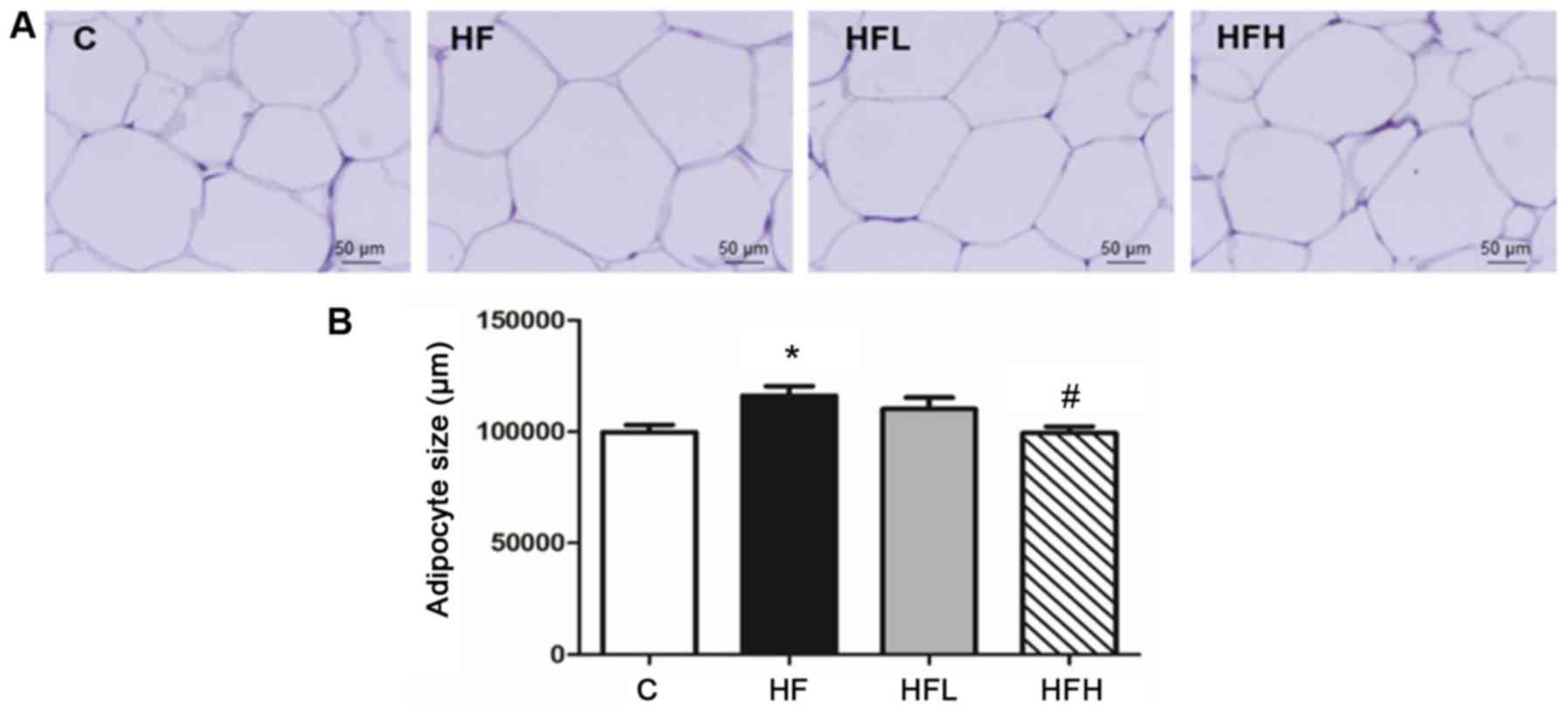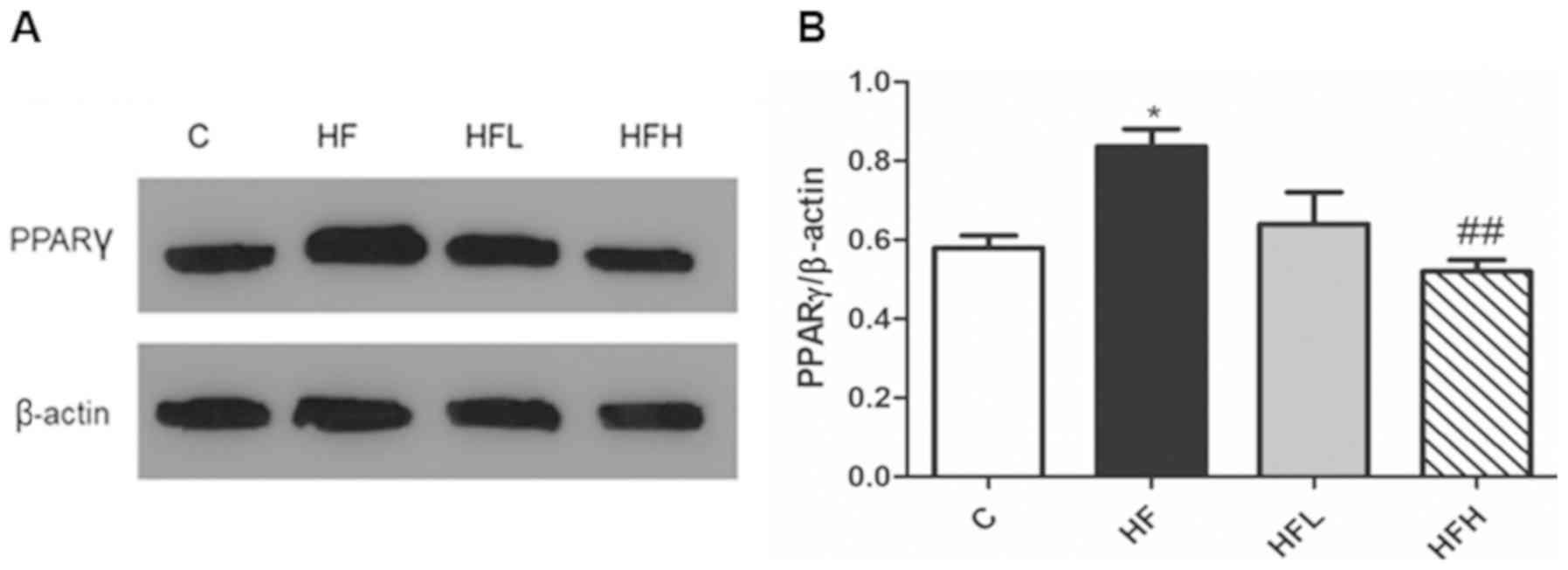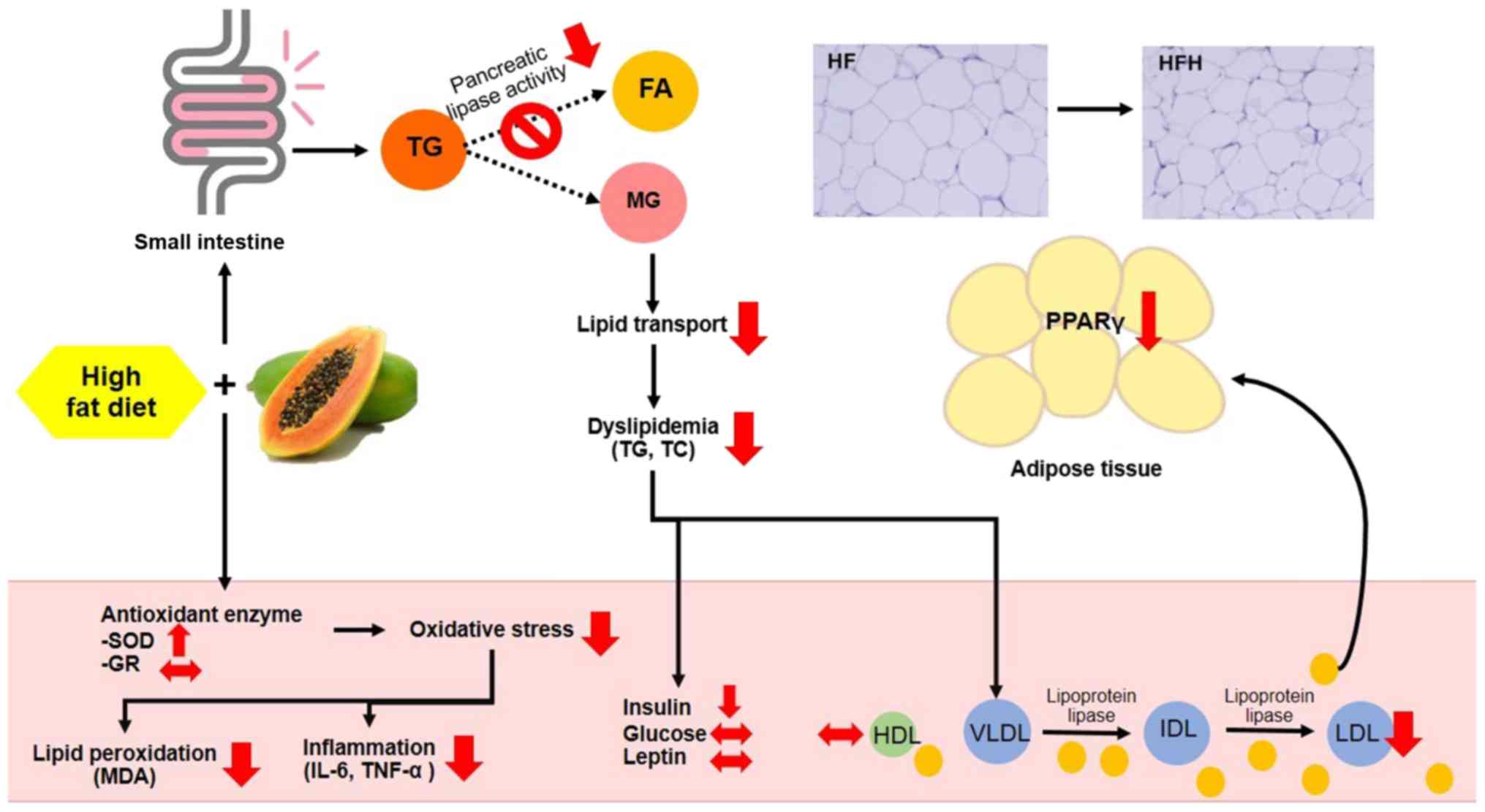|
1
|
World Health Organization (WHO): World
Health Statistics. WHO, Geneva, 2013. http://www.who.int/gho/publications/world_health_statistics/en/index.html.
|
|
2
|
Hariri N and Thibault L: High-fat
diet-induced obesity in animal models. Nutr Res Rev. 23:270–99.
2010.PubMed/NCBI View Article : Google Scholar
|
|
3
|
Schrauwen P and Westerterp KR: The role of
high-fat diets and physical activity in the regulation of body
weight. Br J Nutr. 84:417–27. 2000.PubMed/NCBI View Article : Google Scholar
|
|
4
|
Hruby A and Hu FB: The epidemiology of
obesity: A big picture. Pharmacoeconomics. 33:673–689.
2015.PubMed/NCBI View Article : Google Scholar
|
|
5
|
Pi-Sunyer X: The medical risks of obesity.
Postgrad Med. 121:21–33. 2009.PubMed/NCBI View Article : Google Scholar
|
|
6
|
Food and Agriculture Orgnaization of the
United Nations: Banana, mango, and pineapple, leading fruit
produced and traded worldwide. FAO, Rome, 2007. https://agris.fao.org/agris-search/search.do?recordID=PH2009000126.
|
|
7
|
Saeed F, Arshad MU and Pasha I:
Nutritional and Phyto-therapeutic potential of papaya (Carica
Papaya Linn.): An overview. Int J Food Prop. 17:1637–1653.
2014.
|
|
8
|
Mohamed Sadek K: Antioxidant and
immunostimulant effect of Carica papaya linn. aqueous
extract in acrylamide intoxicated rats. Acta Inform Med.
20:180–185. 2012.PubMed/NCBI View Article : Google Scholar
|
|
9
|
Zetina-Esquivel AM, Tovilla-Zárate CA and
Guzman-Garcia C: Effect of Carica papaya leaf extract on
serum lipids and liver metabolic parameters of rats fed a high
cholesterol diet. Health. 7:1196–1205. 2015.
|
|
10
|
Silva LS, de Miranda AM, de Brito
Magalhães CL, Dos Santos RC, Pedrosa ML and Silva ME: Diet
supplementation with beta-carotene improves the serum lipid profile
in rats fed a cholesterol-enriched diet. J Physiol Biochem.
69:811–820. 2013.PubMed/NCBI View Article : Google Scholar
|
|
11
|
Kameji H, Mochizuki K, Miyoshi N and Goda
T: β-Carotene accumulation in 3T3-L1 adipocytes inhibits the
elevation of reactive oxygen species and the suppression of genes
related to insulin sensitivity induced by tumor necrosis factor-α.
Nutrition. 26:1151–1156. 2010.PubMed/NCBI View Article : Google Scholar
|
|
12
|
McDougall GJ, Kulkarni NN and Stewart D:
Berry polyphenols inhibit pancreatic lipase activity in vitro. Food
Chem. 115:193–199. 2009.
|
|
13
|
Malakul W, Thirawarapan S, Suvitayavat W
and Woodman OL: Type 1 diabetes and hypercholesterolaemia reveal
the contribution of endothelium-derived hyperpolarizing factor to
endothelium-dependent relaxation of the rat aorta. Clin Exp
Pharmacol Physiol. 35:192–200. 2008.PubMed/NCBI View Article : Google Scholar
|
|
14
|
Tsai MC and Huang TL: Thiobarbituric acid
reactive substances (TBARS) is a state biomarker of oxidative
stress in bipolar patients in a manic phase. J Affect Disord.
173:22–26. 2015.PubMed/NCBI View Article : Google Scholar
|
|
15
|
Gregoire FM, Smas CM and Sul HS:
Understanding adipocyte differentiation. Physiol Rev.
78(783)1998.PubMed/NCBI View Article : Google Scholar
|
|
16
|
Mukherjee M: Human digestive and metabolic
lipases-a brief review. J Mol Catalysis B Enzymatic. 22:369–376.
2003.
|
|
17
|
Lunagariya NA, Patel NK, Jagtap SC and
Bhutani KK: Inhibitors of pancreatic lipase: State of the art and
clinical perspectives. Excil J. 13:897–921. 2014.PubMed/NCBI
|
|
18
|
Rochlani Y, Pothineni NV, Kovelamudi S and
Mehta JL: Metabolic syndrome: Pathophysiology, management, and
modulation by natural compounds. Ther Adv Cardiovasc Dis.
11:215–225. 2017.PubMed/NCBI View Article : Google Scholar
|
|
19
|
Furukawa S, Fujita T, Shimabukuro M, Iwaki
M, Yamada Y, Nakajima Y, Nakayama O, Makishima M, Matsuda M and
Shimomura I: Increased oxidative stress in obesity and its impact
on metabolic syndrome. J Clin Invest. 114:1752–1761.
2004.PubMed/NCBI View
Article : Google Scholar
|
|
20
|
Lee H, Lee YJ, Choi H, Ko EH and Kim JW:
Reactive oxygen species facilitate adipocyte differentiation by
accelerating mitotic clonal expansion. J Biol Chem.
284:10601–10609. 2009.PubMed/NCBI View Article : Google Scholar
|
|
21
|
Somanah J, Bourdon E and Bahorun T:
Extracts of Mauritian Carica papaya (var. solo) protect
SW872 and HepG2 cells against hydrogen peroxide induced oxidative
stress. J Food Sci Technol. 54:1917–1927. 2017.PubMed/NCBI View Article : Google Scholar
|
|
22
|
Hosooka T, Noguchi T, Kotani K, Nakamura
T, Sakaue H, Inoue H, Ogawa W, Tobimatsu K, Takazawa K, Sakai M, et
al: Dok1 mediates high-fat diet-induced adipocyte hypertrophy and
obesity through modulation of PPAR-gamma phosphorylation. Nat Med.
14:188–193. 2008.PubMed/NCBI View
Article : Google Scholar
|
|
23
|
Makki K, Froguel P and Wolowczuk I:
Adipose tissue in obesity-related inflammation and insulin
resistance: Cells, cytokines, and chemokines. ISRN Inflamm.
2013(139239)2013.PubMed/NCBI View Article : Google Scholar
|
|
24
|
Ye J: Emerging role of adipose tissue
hypoxia in obesity and insulin resistance. Int J Obes (Lond).
33:54–66. 2009.PubMed/NCBI View Article : Google Scholar
|
|
25
|
Bai SK, Lee SJ, Na HJ, Ha KS, Han JA, Lee
H, Kwon YG, Chung CK and Kim YM: Beta-carotene inhibits
inflammatory gene expression in lipopolysaccharide-stimulated
macrophages by suppressing redox-based NF-kappaB activation. Exp
Mol Med. 37:323–334. 2005.PubMed/NCBI View Article : Google Scholar
|
|
26
|
Manna P and Jain SK: Obesity, oxidative
stress, adipose tissue dysfunction, and the associated health
risks: Causes and therapeutic strategies. Metab Syndr Relat Disord.
13:423–444. 2015.PubMed/NCBI View Article : Google Scholar
|
|
27
|
Asghar N, Naqvi SA, Hussain Z, Rasool N,
Khan ZA, Shahzad SA, Sherazi TA, Janjua MR, Nagra SA, Zia-Ul-Haq M
and Jaafar HZ: Compositional difference in antioxidant and
antibacterial activity of all parts of the Carica papaya
using different solvents. Chem Cent J. 10(5)2016.PubMed/NCBI View Article : Google Scholar
|
|
28
|
Septembre-Malaterre A, Stanislas G,
Douraguia E and Gonthier MP: Evaluation of nutritional and
antioxidant properties of the tropical fruits banana, litchi,
mango, papaya, passion fruit and pineapple cultivated in Reunion
French Island. Food Chem. 212:225–233. 2016.PubMed/NCBI View Article : Google Scholar
|
|
29
|
Amer J, Goldfarb A, Rachmilewitz EA and
Fibach E: Fermented papaya preparation as redox regulator in blood
cells of beta-thalassemic mice and patients. Phytother Res.
22:820–828. 2008.PubMed/NCBI View
Article : Google Scholar
|
|
30
|
Lee S, Keirsey KI, Kirkland R, Grunewald
ZI, Fischer JG and de La Serre CB: Blueberry supplementation
influences the Gut Microbiota, inflammation, and insulin resistance
in High-fat-diet-fed Rats. J Nutr. 148:209–219. 2018.PubMed/NCBI View Article : Google Scholar
|

















